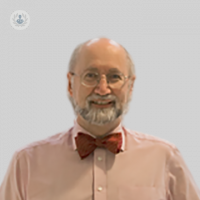Breathlessness – How to breathe correctly (Part 2)
Escrito por:Breathlessness, or dyspnoea, refers to the sensation of having difficulty breathing or feeling short of breath. While feeling breathless from time to time is a natural human response, breathlessness that limits your activities more than normal, occurs at rest, or while carrying out daily tasks such as reaching down to a low cupboard, requires expert assessment and treatment.
Following on from the first of this three-part series of articles on breathlessness, highly renowned consultant cardiologist, Dr Jonathan Pitts Crick, offers an expert insight into the actions that you should take if you feel breathlessness.

What should a patient do when they are feeling breathlessness?
Although breathlessness is not usually due to a lack of oxygen, the agents that can stimulate the respiratory centre are often those that you consciously have no idea about. For this reason, if you are getting breathless and there is no obvious reason for it (for example, a recent virus illness), you should consider why you are breathless and have a specialist look at all of your background history to detect any underlying condition that could be causing your breathlessness.
This underlying condition can be one that prevents your body from getting the oxygen it needs (usually lung disease). These conditions are very easy to detect with a pulse oximeter that you can put on your finger pulse and that will measure your oxygen level (the oxygen saturation of your haemoglobin, which should be over 90 per cent). If you go for a walk and your oxygen level drops, then this will obviously indicate a problem with the lungs.
However, this underlying condition can also be a heart or circulatory condition, or a problem with your body’s metabolism that stimulates the respiratory centre (for example, poor functioning of your kidneys that causes your blood to become more acidic). These conditions can be dangerous, and thus, should be treated promptly and effectively with the help of a specialist. This is because you do not want to be treated for a lung condition, when the danger actually comes from something else. Hence, the first thing that a specialist has to do when it comes to breathlessness is to identify whether there is a potentially dangerous cause for it. This is especially important for people with strong risk factors for coronary disease, heart failure, or similar conditions.
The next thing - after identifying that there is not a dangerous cause for the breathlessness - is to determine the nature of the breathlessness.
People with chronic obstructive airway disease, chronic bronchitis, or emphysema can experience a drop in oxygen levels when they try to exercise. Many do not, but can still be troubled by severe breathlessness – they have been called “pink puffers” in traditional medical textbooks. Either way, their first instinct might then be to breathe more because, of course, their oxygen levels are dropping. However, this is usually not the reason for their breathlessness because, interestingly, lack of oxygen will not make you very breathless. So, even in people who have a lung disease, it is not the lack of oxygen that makes you breathless. It is also not the build-up of carbon dioxide because, in most cases, carbon dioxide is removed from the lungs more easily than oxygen is taken in.
Thus, it is mainly the feeling of tightness in your chest caused by the lung disease obstructing the airflow that causes breathlessness, and that in itself, is not necessarily a reason to breathe more – in fact, it is a reason to breath more slowly.
If a specialist can identify the type of breathlessness, then nearly everyone who is breathless can be treated by being shown how to breathe in a way that is at the right level for the level of activity that they are doing. Obviously, the type of activities that require more breathing are walking up a hill or running – because your body is burning a lot more calories and it needs to have the oxygen to do that. Thus, you have to allow breathlessness to increase your breathing under those conditions, but not too much, because a person with healthy lungs can walk up a hill to the point where the rest of their body is running out of energy, but they are still not short of oxygen.
Head on over to the third part of this series of articles on breathlessness to find out about the main breathing techniques to try if you are feeling breathlessness.
If you are worried about breathlessness and wish to seek expert assessment and treatment for it, do not hesitate to book a consultation with Dr Jonathan Pitts Crick via his Top Doctors profile today.


